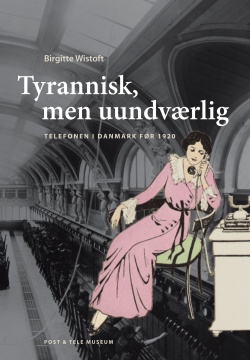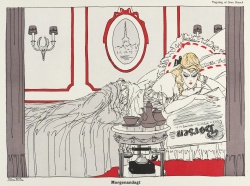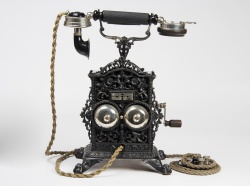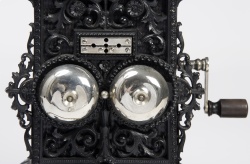The Early Days of the Telephone in Denmark
01. Apr. 2007

"When the pin is left in the middle hole, it causes a fuss. The apparatus is useless, a messenger is sent to the exchange, a technician is called and some-time has to travel for miles just to remove the small pin. Therefore, when an apparatus does not work, it should be checked if the pin is in the upper hole where it should be. When the apparatus is being dusted in the morning, the pin often falls out and is placed in the wrong hole by the maid".
The admonition to the subscribers is not only re-vealing that it took quite some time before people were able to manage the technique. It also reveals who were the main customers during the first dec-ades after the introduction of the telephone in Den-mark - the bourgeoisie with high incomes and domestic servants.
The example is just one of many by which Birgitte Wistoft, director of Post & Tele Museum, is throwing light on early Danish telephony in her new book "Tyrannisk, men uundværlig - telefonen i Danmark før 1920". ["Tyrannical, but indispensable - the Telephone in Denmark before 1920"]. The book is focusing on the telephone users by telling the story about their attitude to and use of Alexander Gra-ham Bell's groundbreaking invention from 1876. But as the author shows, long time passed before the Danes actually looked upon the telephone as groundbreaking. They already had excellent com-munication my means of the postal service and the telegraph. And it took several decades for the telephone to become really popular.

Morning Devotions, Svikmøllen [The Cross-Ruff], 1917. Nightmare or vision of the future? Young, beautiful, liberated woman takes pleasure in the financial news at breakfast underneath a picture of the Copenhagen Stock Exchange - and with the telephone within reach.
(c) Sven Brasch/billedkunst.dk
A Slow and Chequered Beginning
A true undergrowth of small local telephone com-panies came and disappeared, merged and grew bigger until the telephone network was fully ex-tended geographically in Denmark by the early 1920's. During the past decades the number of subscribers had increased from modest 22 to 220,000.
Birgitte Wistoft's book reveals that the high price and poor, technical quality with noise and frequent dropouts on the line were not the only problems the companies had in their endeavour to expand their prospective clientele. The users' attitude towards the telephone was perhaps an even bigger impedi-ment to the popularization of the telephone in this country. Not only were the subscribers charged a high tariff to enjoy the latest technological develop-ment; they also had to be willing to let the tele-phone into their best parlours. To the primary target group of the companies their private sphere turned out to be a sanctuary which held its ground for a long time, and not everybody would eventually let the telephone slip into their home. Even the business tycoon C.F. Tietgen, founder and chairman of the Copenhagen Telephone Company Ltd. (KTAS), never got a telephone in his house.

A Norwegian produced telephone from 1893 with holes for the pin which often caused fault complaints. Photo: Jan Friis.
As a consequence of this attitude the telephone lead a life in the office rather than in the private home if those who could afford a telephone chose to acquire one at all. The exchange of letters and the visiting culture of the upper classes were not easily superseded.
„A Devilish Device"
Birgitte Wistoft's book is based on a thorough and impressive search in the printed media of that time which reveals that although the telephone only slowly gained ground, it was by no means absent from public consciousness. It is jocularly called a "devilish device" in a revue song of the time, and a "tyrannical", but indispensable aid in "The Manners of Good Society" by Emma Gad. This view of the telephone would reappear in the entertaining car-toons that emerged in the pulp magazines of the time. Here the telephone was often implicated in some misunderstanding owing to all kinds of things like noise on the line, lack of familiarity with the operation of the apparatus, or fierce attacks on the indispensable female telephone operators.

Another characteristic of the time was the formula-tion of a notion which turned out to be extremely persistent - i.e. the woman as a talkative and ever-twittering user of the telehone. The book contains several satirical drawings of young, lovely, and lightly dressed women with the receiver in their hand treating their female friend to the latest gossip or their husband at the office to sweet words. But Wistoft is also demonstrating that the telephone did not only maintain women in the current roles, it was also part of their attempt to undertake new roles. The telephone was a commercial lifestyle product - a symbol of wealth and enterprise - and the increasing group of self-employed women did not hesitate to embrace the apparatus. The tyrannical, but indispensable telephone was here to stay.
„Tyrannisk, men uundværlig - telefonen i Danmark før 1920" [only available in Danish] will be out on 1st June 2007. The book is format A4, hard cover, with 224 richly illustrated pages. The price is DKK 298 + DKK 50 for postage and packing.
This article may be copied or quoted with MuseumsPosten, Post & Tele Museum as source.
Comment this article
Only serious and factual comments will be published.